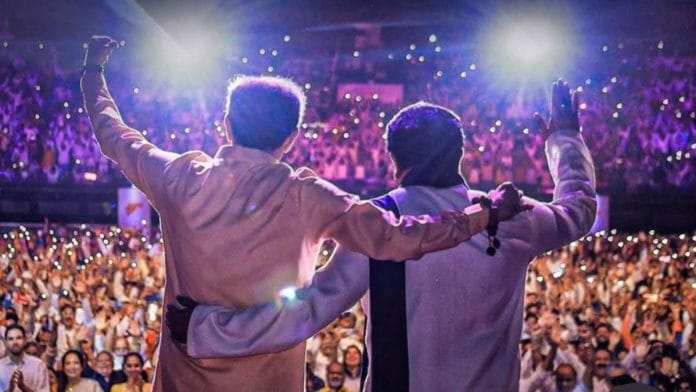Thank you dear subscribers, we are overwhelmed with your response.
Your Turn is a unique section from ThePrint featuring points of view from its subscribers. If you are a subscriber, have a point of view, please send it to us. If not, do subscribe here: https://theprint.in/subscribe/
Symbolism has been a pivotal tool in politics that is utilized under different circumstances for a long drawn impact, political communication and political mobilization. Symbolism has been used in the shaping of a collective memory of a population that generally gets assimilated through an imagined understanding of oneness as a nation-state. Symbolism has been a driving factor of socio- cultural, linguistic movements taking place at regional level. Symbolism shaped the linguistic reorganization movement f or the formation of the state of Maharashtra. The Samyukta Maharashtra movement took place between 1955- 1960 that ultimately resulted in the formation of the state of Maharashtra on 1st May 1960. The movement was organized around the idea of reinstating the pride of Marathi identity and emboldening the rich legacy of Marathi asmita for the creation of unified state of Maharashtra for Marathi speaking people. During the movement political parties, social organizations and political leaders made active use of speeches, flags, pamphlets, cartoons for redrawing a collective political imagination of the masses for mobilizing towards the goal of creating unified Maharashtra with Mumbai as its capital city.
Symbolic politics has long been a defining feature of Maharashtra’s political landscape, particularly through the actions and rhetoric of the Shiv Sena (UBT) and the Maharashtra Navnirman Sena (MNS). Both the parties have consistently leveraged identity, language, and cultural pride to mobilize support and assert influence, especially in Mumbai and other urban centers.
Founded in 1966 by Bal Thackeray, Shiv Sena emerged as a nativist force championing the rights of the “sons of the soil” the Marathi-speaking population of Mumbai. Its politics were rooted in aggressive performative nationalism, often expressed through street-level activism, provocative speeches, and cultural symbolism
Bal Thackeray in many ways re-crafted and rebranded the politics of symbolism in regional politics. Bal Thackeray evoked new flavor of symbolic politics first through his cartoons in the weekly journal Marmik and later through his fiery articles along with expressive cartoons in the Shiv Sena mouth piece Samna. Bal Thackeray’s Shiv Sena entered Maharashtra’s electoral politics in 1970s with a subtle messaging of ‘Marathi Manoos Jaga ho’ and reinforcing Marathi pride galvanized through centuries old legacy of Chatrapati Shivaji Maharaj.
The party’s early campaigns targeted South Indians and later North Indians, portraying them as economic threats to Maharashtrians. Over time, Shiv Sena expanded its ideological base to embrace Hindutva, aligning with the BJP and becoming a significant player in state and national politics.
The MNS, formed in 2006 by Raj Thackeray after splitting from Shiv Sena, inherited much of this symbolic toolkit but sharpened its focus on Marathi identity. Raj’s leadership style mirrored Bal Thackeray’s fiery oratory and populist appeal, but MNS struggled to replicate Shiv Sena’s electoral success. Nonetheless, MNS made headlines through dramatic actions such as attacking shops with non-Marathi signboards or confronting migrants which reinforced its image as a protector of Marathi pride.
In recent years, symbolic politics has taken new forms. The reunion of Raj and Uddhav Thackeray in July 2025 over the issue of Marathi language marked a significant moment in Maharashtra’s political narrative. Their joint rally opposing the Government Resolution mandating Hindi in schools was not just a protest against language imposition but a strategic move to reclaim the Marathi identity space.
This collaboration, after years of rivalry, signals a renewed emphasis on cultural symbolism as a unifying force amid fragmented party politics.
The loss of Shiv Sena’s traditional symbol to the Eknath Shinde faction and the subsequent decline in electoral performance of Uddhav’s faction have made symbolic politics even more crucial. Without the iconic bow-and-arrow symbol, Uddhav’s Sena has had to rely more heavily on emotional appeals to Marathi pride and legacy. Similarly, MNS, with limited electoral reach, continues to use symbolic gestures such as language enforcement and cultural rallies to stay relevant.
Symbolic politics in Maharashtra, as practiced by Shiv Sena and MNS, is not merely about identity assertion; it is a response to the socio-political anxieties of urban Maharashtrians. It reflects a struggle for cultural preservation in a rapidly globalizing and diversifying urban space. While critics argue that such politics can be exclusionary and divisive, its persistence underscores its resonance with a significant section of the electorate.
As Maharashtra heads into the BMC elections, the interplay of symbolic politics, identity narratives, and strategic alliances will likely shape the future of both Shiv Sena (UBT) and MNS. Whether this leads to a consolidation of Marathi political identity or further fragmentation remains to be seen.
Dr. Kunwar Siddarth Dadhwal
Assistant Professor,
Chitrakoot School of Liberal Arts,
Shoolini University (Solan, Himachal Pradesh)
These pieces are being published as they have been received – they have not been edited/fact-checked by ThePrint.


